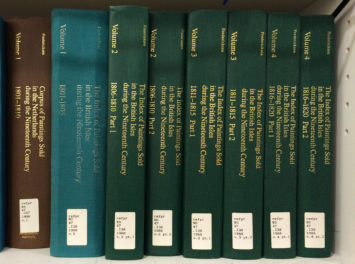
Outside the Woman’s Building, 1975. The Getty Research Institute, 2018.M.16. Photo: Maria Karras. Gift of Maria Karras. © Maria Karras, BFA, RBP, MA
In 1973, artist Judy Chicago, designer Sheila Levrant de Bretteville, and art historian Arlene Raven changed the cultural landscape by founding the Woman’s Building in downtown Los Angeles. For two decades the Woman’s Building played a crucial role in the national women’s movement, shaping both the field of feminist art and American arts education.
On June 8, 2018, thanks to the efforts of the Los Angeles Conservancy and passionate community support, the City Council designated the Woman’s Building a Historic-Cultural Monument. The designation ensures the long-term protection of a building described by art critic and activist Lucy Lippard as “the capital of cultural feminism.”(1)

The Woman’s Building, 1976. The Getty Research Institute, 2018.M.16. Photo: Maria Karras. Gift of Maria Karras. © Maria Karras, BFA, RBP, MA
Now, we are thrilled to announce that, thanks to funding from the Save America’s Treasures grant program, the Getty Research Institute will preserve important archives documenting the groundbreaking artistic, educational, and political activities of the Woman’s Building. Administered by the Institute of Museum and Library Services in collaboration with the National Park Service, the grant program funds projects that preserve “nationally significant historic properties and collections that convey our nation’s rich heritage to future generations of Americans.”
Each collection in this project is valuable on its own terms, from the Woman’s Building records and videos to the archives of several feminist artists and artist groups who were active at the Woman’s Building, including Nancy Buchanan, Barbara T. Smith, Faith Wilding, Feminist Art Workers, Mother Art, Sisters of Survival, and the Waitresses. But considered together, they illuminate—in strikingly poignant ways—major initiatives, struggles, and dynamics of the women’s movement from the 1960s to the twenty-first century.
The Woman’s Building
As reflected in its archives, the Woman’s Building was not just a physical structure. It was also an innovative educational institution and an organizational center for the feminist movement.
The heart of the Woman’s Building was the Feminist Studio Workshop (FSW), one of the first independent art schools for women. Based on a feminist pedagogical model rooted in the idea that collectivity and a safe, inclusive environment are essential for women artists to develop, the FSW provided an alternative to traditional arts education and the male-dominated environment at CalArts, where all three founders previously taught.(2)
Rather than painting and sculpture—media championed by traditional art schools—the FSW curriculum emphasized video, writing, performance, and graphic design. The Women’s Graphic Center and the Los Angeles Women’s Video Center, located within the Woman’s Building, offered opportunities for training, experimentation, and self-expression in new media.
The Woman’s Building was also home to art galleries, performance spaces, and feminist-owned businesses. Exhibitions ranged from single-artist surveys to vast thematic explorations like The Great American Lesbian Art Show (1980). For the artists noted above, as well as Margaret Atwood, Judy Baca, Audre Lorde, Rachel Rosenthal, Adrienne Rich, Martha Rosler, Betye Saar, and many more, the Woman’s Building was a supportive space for artists and writers to develop and present their work, individually and collaboratively.(3)
The Woman’s Building Collections
The archive of the Woman’s Building as an organization offers an overview of the building’s activities from its founding until it closed in 1991. Contents include announcements, posters, manuscript material, and thousands of images of exhibitions, readings, performances, and the building itself.

Woman’s Building remodeling and reconstruction, 1975. The Getty Research Institute, 2018.M.16. Photo: Maria Karras. Gift of Maria Karras. © Maria Karras, BFA, RBP, MA
Among more than 250 videos in the Woman’s Building collection are numerous oral histories, now-iconic feminist video art works like Nun and Deviant (1976) by Nancy Angelo and Candace Compton, as well as documentation of events and performances such as In Mourning and In Rage (1977), an influential public media performance staged by Suzanne Lacy and Leslie Labowitz on the steps of City Hall to protest violence against women and sensationalist news coverage of the “Hillside Strangler.”

In Mourning and In Rage, 1977, Suzanne Lacy and Leslie Labowitz. The Getty Research Institute, 2018.M.16. Photo: Maria Karras. Gift of Maria Karras. © Maria Karras, BFA, RBP, MA and courtesy of Suzanne Lacy and Leslie Labowitz-Starus
Over the years, several feminist artist groups emerged from the Woman’s Building. Their archives, many of which were donated to the Getty Research Institute by the artists themselves, reflect the range of artistic approaches that stemmed from the idea of collectivity that was so central to the Woman’s Building.
In 1973, the artist collective Mother Art was formed by FSW participants to address practical needs, such as childcare at the Woman’s Building, and to produce sociopolitical art projects focused on pressing issues such as immigration, abortion, and homelessness. The Feminist Art Workers, formed in 1976 by Angelo, Compton, Cheri Gaulke, Laurel Klick, and later Vanalyne Green, incorporated feminist pedagogical techniques in participatory performance art. In 1977, Jerri Allyn and Anne Gauldin cofounded the Waitresses, a performance art group that used humor to explore issues related to women’s labor, with a focus on topics that still resonate today, including sexual harassment, stereotypes, and wage inequality. Sisters of Survival, an anti-nuclear performance art group founded in 1981 by Allyn, Angelo, Gauldin, Gaulke, and Sue Maberry, toured and collaborated with other anti-nuclear activist groups throughout the United States and Europe.

Ready to Order? 1978, The Waitresses. Photo: Maria Karras. The Getty Research Institute, 2017.M.45. Gift of Jerri Allyn and Anne Gauldin, The Waitresses.
The archives of individual artists who contributed to the Woman’s Building present diverse perspectives on the women’s movement and the intersection of feminist activism and the visual arts, particularly in Southern California. Faith Wilding was one of the inaugural members of the Woman’s Building, and her archives reflect the diffusion of West Coast-based feminist art and theory throughout the United States. The papers and videos of Nancy Buchanan, a pioneer of performance, video and conceptual art, show how feminist artists used art as a tool for raising awareness of contemporary political and social issues.

Drawing of Rosa/Subrosa platform, 2008, Faith Wilding. The Getty Research Institute, 2017.M.8.
In addition to documenting the history of the Woman’s Building, the collections are also rich resources for the study of performance art, video art, and the history of art in Southern California more broadly.
The Project
Thanks to the Save America’s Treasures grant, the Getty Research Institute can accelerate processing and preservation of 11 archives, and digitization of materials most at risk of deterioration. Speedy completion of the work is particularly important given the salience of the collections to current events in the United States and ongoing activism around women’s rights.
Grant-funded digitization efforts will focus on acetate and magnetic media that are at particularly great risk of deterioration. These include thousands of photographic negatives and slides, several hundred audio and video recordings, and more than 40 film reels. Because fluctuations in temperature and humidity can be quite harmful to acetate film and magnetic media, storing them in a climate-controlled environment is critical to their preservation. Digitization of this material will allow us to make digital versions available for research, while the originals remain safely in storage.
The digitization project will also include critical films and audio and video recordings from the papers of Barbara T. Smith, an influential figure in the history of feminist art and performance art in Southern California. While much of her archive is already available for research, these items have been unavailable due to conservation concerns.

Note on the performance Feed Me, 1973, Barbara T. Smith. The Getty Research Institute, 2014.M14. © Barbara T. Smith
The two-year project begins in December 2018 and ends in November 2020. Once processed and preserved, all of the archival collections will be freely accessible for research.
To get announcements of the completion of processing and digitization of each collection, follow the Getty Research Institute Facebook page or subscribe to our e-newsletter.
Notes
1. Lucy Lippard, “Forward: Going Around in Circles,” in From Site to Vision: The Woman’s Building in Contemporary Culture, eds. Sondra Hale and Terry Wolverton (Los Angeles: Otis College of Art and Design and the Woman’s Building, 2011), 12.
2. Jenni Sorkin, “Learning from Los Angeles: Pedagogical Predecessors at the Woman’s Building,” in Doin’ It in Public: Feminism and Art at the Woman’s Building, eds. Meg Linton and Sue Maberry (Los Angeles: Otis College of Art and Design, 2011), 37.
3. “Timeline,” the Woman’s Building, accessed October 29, 2018, http://thewomansbuilding.org/timeline.html. The timeline on the Woman’s Building website includes a fairly comprehensive list of exhibitions, performances, video art, literary events and educational programs from 1968 to 1991.
_____
Getty Research Institute Special Collections contain many archives related to the Woman’s Building that are already available for research, many of which are listed in our guide to Archives and Resources for Feminist Research.




Comments on this post are now closed.